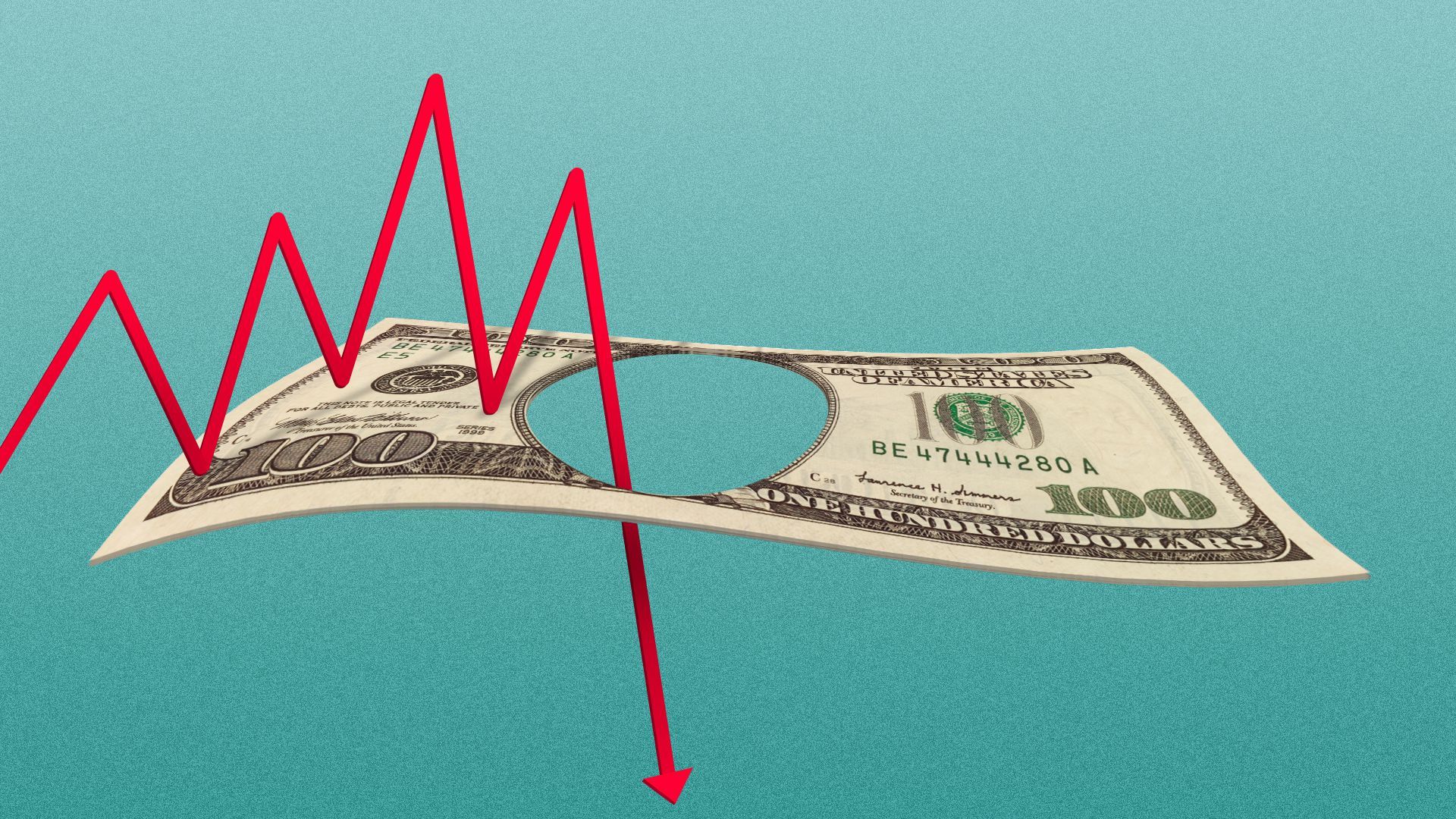| | | | | | | Presented By Williams Companies | | | | Axios Markets | | By Kate Marino ·Nov 15, 2021 | | 👋 Good morning! It's Monday. Please enjoy this kitten tweet. ⏳ Today's newsletter is 1,207 words, a 5-minute read. | | | | | | 1 big thing: America's teacher shortage |  | | | Illustration: Rae Cook/Axios | | | | Nearly every sector is dealing with a pandemic-era labor shortage, but the problem is especially acute in public education, Axios' Erica Pandey writes. - Here, the problem pre-dates the pandemic — stemming in large part from stagnant wages — and has consequences we're yet to comprehend on the education and well-being of the next generation.
The big picture: Demand for teachers is drastically outpacing supply. Many teachers are retiring or quitting the profession due to pandemic-era stress, and universities aren't minting new ones fast enough. Why it matters: Schools are hurriedly navigating the shortage, switching to virtual learning, or closing down on certain days entirely — a drain on parents that may want to reenter the workforce. By the numbers: Nationally, there were 575,000 fewer local and state education employees in October 2021 than in February 2020, according to the latest jobs report. - And while health concerns and the stress of flitting between virtual and in-person education drove teachers, school support staff and administrators out in 2020, they're not coming back to school even as the pandemic subsides.
- A net of 65,000 public education employees left the industry between September and October alone, per the Bureau of Labor Statistics.
What's happening: "Teacher salaries had fallen in the few years even before the pandemic, reducing the supply of teachers," says Susanna Loeb, an education economist and director of Brown's Annenberg Institute. - "So the shortage of teachers may actually be greater than the shortage in other areas, which are more pandemic related."
The wage gap between teachers and the rest of the comparably educated workforce was about 21% in 2018. That disparity was a much smaller 6% back in 1996, according to an analysis from the Economic Policy Institute. - And while teacher pay has gone up this year, the group's wage gains of 0.7% in the last quarter were just half the 1.5% average for all civilian workers.
All that's pushing existing instructors to pivot to new careers and discouraging new college graduates from becoming teachers. - "Our state universities aren't producing enough teachers for the state," Justin Fryer, superintendent of Lisbon Public Schools in North Dakota, tells Axios.
The impact: When teachers take days off or have to enter quarantine due to COVID-19, districts can't backfill them. "Finding substitutes has been a tremendous problem," Fryer says. - After all, in some cases it pays more to work at McDonald's than be a substitute teacher in the U.S., Bloomberg reports.
The bottom line: Fixing the broken labor market for teachers comes down to funding, experts say. - "We have to rebuild a profession that has been chipped away at," says Rice.
Go deeper. |     | | | | | | 2. Catch up quick | | The backlog at ports is leading to an export crisis for American farms, which are struggling to get their products out of the country. The disruptions may have cost the U.S. dairy industry alone about $1 billion during the first half of 2021. (NYT) UBS portfolio managers are leaving the firm after their Asia fixed income portfolio sustained hefty losses tied to China's high yield bond meltdown. (Bloomberg) Elon Musk appeared to offer to sell more of his Tesla stock while sparring with Sen. Bernie Sanders on Twitter. (Reuters) New rules allowing college athletes to make money from endorsement deals aren't just accruing benefits to the highest-profile figures. Athletes in less popular sports like volleyball and water polo, who have strong social media followings, have been able to profit in the new paradigm. (WSJ) |     | | | | | | 3. Treasury turbulence |  | | | Illustration: Annelise Capossela/Axios | | | | Jitters from the latest inflation data popped up across the market, from a selloff in equities to medium-term Treasury yields zooming higher. - Another under-the-radar result: A startlingly weak auction for 30-year Treasuries.
Why it matters: A sloppy Treasury auction could send signals about investor demand and the direction of rates — so markets will be watching to see if there's a repeat. What's happening: Wednesday's auction produced an unusually large tail — a measure of the difference between the expected and actual interest rate (5.2 basis points, in this case). - "The tail of the auction was quite dramatic … It's been several years since we saw a tail of this magnitude," Subadra Rajappa, head of U.S. rates strategy at Société Générale, tells Axios.
- The bid-to-cover ratio — the number of bids for the paper being offered — was also the lowest in an auction since February. Primary dealers like banks took down a larger than normal portion of the notes because other bidders stepped back, according to a Société Générale research note.
The big picture: This all signaled that for a time on Wednesday, demand for the notes was less than expected. - "Given the strength in the [CPI] data earlier in the morning, that probably weighed on people's decisions," says Steve Rodosky, PIMCO portfolio manager for real return and U.S. long-duration strategies.
- Another factor: the surprisingly low level to which rates had sunk, even as inflation picked up, may have given bidders pause, Rajappa says.
Yes, but: "I wouldn't extrapolate too much from one auction result. A bigger concern would be if we see more auctions like this, where there's weak demand from end investors," Rajappa adds. The bottom line: Stocks have recovered much of their post-CPI losses, and Treasuries have stabilized. - But with another strong inflation print likely next month, and more investors betting that rates will soon rise, watch for more volatility in Treasuries.
|     | | | | | | A message from Williams Companies | | Williams is committed to building a clean energy future | | |  | | | | By exploring emerging fuel sources like green hydrogen, carbon capture and renewable natural gas, Williams is on a path to net-zero emissions by 2050. And we're investing in the innovators who will create clean energy solutions we can't even imagine yet. Learn more. | | | | | | 4. Charted: Why it's tough to hire |  Data: FRED; Chart: Axios Visuals By many metrics, the labor market keeps getting tighter. One of those measures is a ratio showing that for every job opening in September, there was way less than one person actually seeking a job. - The 0.7 job seekers available per job is an all-time record low with the exception of one month — April 2019 — when the stat hit 0.69, according to the government's Job Openings and Labor Turnover (JOLTS) report, released Friday.
Why it matters: Layer that lopsided ratio onto a situation in which job seekers' skills and geographic locations may be at a mismatch with employer needs — and it's a recipe for hiring challenges. State of play: Job quits also hit a new record in September, at 3% of the total workforce, besting several records set earlier this year. - With workers in high demand, they're able to more easily hop to new jobs with higher pay or better conditions.
|     | | |  | | | | If you like this newsletter, your friends may, too! Refer your friends and get free Axios swag when they sign up. | | | | | | | | 5. What we're watching this week |  | | | Illustration: Eniola Odetunde/Axios | | | | Retail sales data for October will show if the divergence between consumer sentiment — near recent record lows — and actual consumer behavior is continuing into the fourth quarter. Flashback: The closely watched University of Michigan Consumer Sentiment Index recently sunk even lower than its reading at the peak of pandemic-induced lockdowns. - As the index plummeted, economists pulled back consumer spending forecasts — but retail sales handily beat consensus expectations and are far higher than their pre-COVID levels.
By the numbers: October sales are expected to be up 1.2% compared to September, according to FactSet. That's after growth of 0.7% and 0.9% in the prior two months (expectations for both had been negative). Reality check: Price inflation will contribute to the absolute spending growth — the Consumer Price Index was up 0.9% in October — so we'll be watching to see if, and by how much, retail sales growth exceeds the rate of price gains. |     | | | | | | A message from Williams Companies | | Natural gas can help accelerate innovation while reducing emissions | | |  | | | | Replacing coal generation with natural gas will balance sustainability and climate goals while meeting growing energy demand. Williams' existing infrastructure provides a path to a lower carbon footprint by delivering clean natural gas while looking forward to new clean energy solutions. | | | | 📫 Thanks for reading. If this email was forwarded to you, click here to sign up for Markets or any of Axios' other free newsletters. |  | | It'll help you deliver employee communications more effectively. | | | | | | Axios thanks our partners for supporting our newsletters. If you're interested in advertising, learn more here.
Sponsorship has no influence on editorial content. Axios, 3100 Clarendon Blvd, Suite 1300, Arlington VA 22201 | | | You received this email because you signed up for newsletters from Axios.
Change your preferences or unsubscribe here. | | | Was this email forwarded to you?
Sign up now to get Axios in your inbox. | | | | Follow Axios on social media:    | | | | | |












No comments:
Post a Comment